Emails remain one of the most effective digital marketing channels. But does that mean you should send an email any time you want to engage your audience? Absolutely not. You need to understand the right time to use emails and which types of emails are best for your needs.
Email marketing should be used when promoting special offers, such as discounts or free shipping. It’s also an effective tool for engaging customers and segmenting your audience to target specific groups. You can also use email marketing to invite your contacts to an event.
Let’s go through each point in more detail to help you understand when to use email marketing. It can be used for many different purposes, but it’s not a catch-all.
7 Instances You Can Use Email Marketing
While sending emails can be a great way to reach customers and drive sales, it should be used sparingly and thoughtfully. Here are 7 ways you can use email marketing for your business:

1. When Promoting Special Offers
Who doesn’t like a good deal? Promoting special offers via email is one of the most effective ways to drive traffic and sales.
You can use emails to inform customers about new products or services, limited-time discounts, or exclusive deals.
These emails are common during the holidays, but you can also use them to promote seasonal sales. Your goal should be to make the offer attractive and easy to understand.
It’s likely that only 2 out of every 10 people that receive your email will open it, so you need to make every effort to stand out.
You should also include a clear call-to-action so customers know how to take advantage of your offer. Make the CTA button stand out and use strong words to encourage people to click.
Instead of “Buy now,” use words like “Claim your offer.” This approach makes the customer feel it is about them and not you.

2. When Building Relationships with Customers
You can use emails to build relationships with your customers. These emails should give customers valuable information about you and your company.
A newsletter is one of the most effective ways to keep customers informed and engaged. Most companies send newsletters on a weekly or monthly basis.
These emails should include interesting and relevant content.
Newsletters are also an effective way to promote new products or services and upcoming events or promotions. You can also use them to tell stories about your brand and its growth.
Remember to keep the content short and sweet, as people don’t have time to read long emails. Also, use photos or infographics to add visual appeal and break up the text.
As the adage goes, “A picture is worth a thousand words.” The format of your emails should also be mobile-friendly so they can be read easily on any device.
There is a higher chance that customers will open and read your emails if they look good on mobile devices.
3. When Engaging Loyal Customers
Your existing customer base is probably the most important source of new sales, referrals, and brand loyalty.
Email marketing is a great way to communicate with them and strengthen relationships.
This category of emails should be used to thank customers for their business, provide helpful information, or ask for feedback. You can also use them to offer exclusive deals or discounts.
You should also consider sending out surveys and polls via email. They are a great way to collect customer feedback and get insights into what your audience wants.
Using emails to contact total strangers is considered spam. Spamming can damage your reputation, and you could even get blocked by ISPs.
Therefore, you should ensure your email list only contains people who have signed up for your communications. However, there can be exceptions depending on the context.
For example, you might email potential customers if they have downloaded something from your website or interacted with you in some other way.
4. When You Want to Address a Specific Audience
Segmenting your audience allows you to target specific customer groups and send more personalized emails.
For example, if you have a large customer base, you can segment them by gender, age, location, or interests.
You can increase open rates and click-throughs by segmenting your audience and sending targeted emails.
You should also consider using an email automation tool to send personalized messages based on the customers’ previous engagement with your emails.
Unlike social media or other forms of marketing, segmentation enables you to reach a single person with multiple messages.
This allows you to fine-tune your message based on customer preferences and interests.

5. When Following Up on Abandoned Cart
Abandoned cart emails are sent when a customer adds an item(s) to their cart but leaves without completing the purchase. These emails are highly effective and can result in more sales.
You should personalize these emails by including the customer’s name, a product image, or a discount code to encourage them to complete their purchase.
You should also use compelling CTA buttons that stand out, such as “Accept Your Discount and Complete Your Order.” When sending abandoned cart emails, use a friendly and conversational tone.
This will make customers feel you understand their situation and are willing to help them. You might also consider setting up automated emails that will be sent when a customer abandons their cart.
6. When You Want to Nudge Inactive Customers
Several times, I have received emails from a company asking me where I have been or offering me a discount to come back.
It’s important to re-engage inactive customers and encourage them to purchase from you again.
When I receive such an email, I usually feel that the company cares about me and wants to keep me as a customer.
You can consider using incentives such as loyalty points or discounts for inactive customers who make a purchase. This will help to bring them back and encourage more engagement with your brand.
The cost of acquiring new customers is often higher than retaining existing ones.
Therefore, email marketing should be used to nurture customer relationships and keep your brand top-of-mind for current and prospective customers.
Re-engaging inactive customers should also be part of your email marketing strategy.
7. When Inviting People to Events
We are living in an era where virtual events are becoming more and more popular. Email marketing is a great way to spread the word if you have an upcoming event.
You can create engaging emails highlighting the key benefits of attending your event and using CTA buttons to direct people to a registration page.
One great thing about email marketing is that you can track the performance of your emails.
This will give you valuable insights to improve future campaigns and help you refine your messaging for the best results.
You can also estimate the number of people who will attend your events based on the open rate of your emails.
Email marketing can also be used to remind people about an upcoming event and encourage them to register.
You should also consider sending follow-up emails to thank attendees and ask for feedback after the event.

Key Takeaways
Email marketing is an effective tool to help you build relationships with customers, engage them, and increase sales.
The channel can be used to promote special offers, send regular newsletters, and communicate with people who know about you or your company.
You can also use email marketing to segment your audience, follow up on abandoned carts, or nudge inactive customers.
Additionally, email marketing can be used to invite people to events and track the performance of your campaigns.
